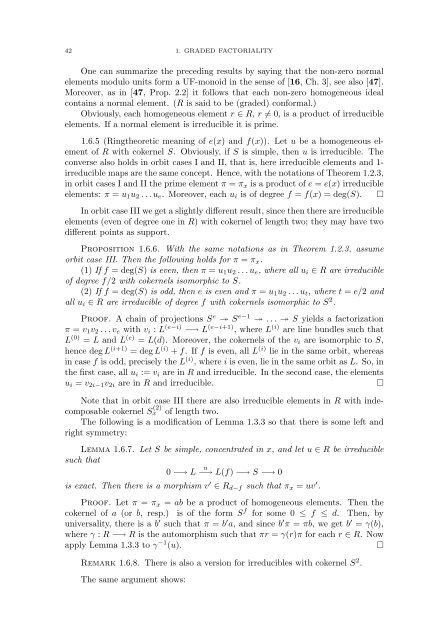MEMOIRS
MEMOIRS
MEMOIRS
- No tags were found...
You also want an ePaper? Increase the reach of your titles
YUMPU automatically turns print PDFs into web optimized ePapers that Google loves.
42 1. GRADED FACTORIALITYOne can summarize the preceding results by saying that the non-zero normalelements modulo units form a UF-monoid in the sense of [16, Ch. 3], see also [47].Moreover, as in [47, Prop. 2.2] it follows that each non-zero homogeneous idealcontains a normal element. (R is said to be (graded) conformal.)Obviously, each homogeneous element r ∈ R, r ≠ 0, is a product of irreducibleelements. If a normal element is irreducible it is prime.1.6.5 (Ringtheoretic meaning of e(x) andf(x)). Let u be a homogeneous elementof R with cokernel S. Obviously, if S is simple, then u is irreducible. Theconverse also holds in orbit cases I and II, that is, here irreducible elements and 1-irreducible maps are the same concept. Hence, with the notations of Theorem 1.2.3,in orbit cases I and II the prime element π = π x is a product of e = e(x) irreducibleelements: π = u 1 u 2 ...u e . Moreover, each u i is of degree f = f(x) =deg(S). □In orbit case III we get a slightly different result, since then there are irreducibleelements (even of degree one in R) with cokernel of length two; they may have twodifferent points as support.Proposition 1.6.6. With the same notations as in Theorem 1.2.3, assumeorbit case III. Then the following holds for π = π x .(1) If f =deg(S) is even, then π = u 1 u 2 ...u e , where all u i ∈ R are irreducibleof degree f/2 with cokernels isomorphic to S.(2) If f =deg(S) is odd, then e is even and π = u 1 u 2 ...u t ,wheret = e/2 andall u i ∈ R are irreducible of degree f with cokernels isomorphic to S 2 .Proof. A chain of projections S e ↠ S e−1 ↠ ... ↠ S yields a factorizationπ = v 1 v 2 ...v e with v i : L (e−i) −→ L (e−i+1) ,whereL (i) are line bundles such thatL (0) = L and L (e) = L(d). Moreover, the cokernels of the v i are isomorphic to S,hence deg L (i+1) =degL (i) + f. Iff is even, all L (i) lie in the same orbit, whereasin case f is odd, precisely the L (i) ,wherei is even, lie in the same orbit as L. So,inthe first case, all u i := v i are in R and irreducible. In the second case, the elementsu i = v 2i−1 v 2i are in R and irreducible.□Note that in orbit case III there are also irreducible elements in R with indecomposablecokernel S x(2) of length two.The following is a modification of Lemma 1.3.3 so that there is some left andright symmetry:Lemma 1.6.7. Let S be simple, concentrated in x, andletu ∈ R be irreduciblesuch that0 −→ L −→ uL(f) −→ S −→ 0is exact. Then there is a morphism v ′ ∈ R d−f such that π x = uv ′ .Proof. Let π = π x = ab be a product of homogeneous elements. Then thecokernel of a (or b, resp.) is of the form S f for some 0 ≤ f ≤ d. Then, byuniversality, there is a b ′ such that π = b ′ a, and since b ′ π = πb, wegetb ′ = γ(b),where γ : R −→ R is the automorphism such that πr = γ(r)π for each r ∈ R. Nowapply Lemma 1.3.3 to γ −1 (u).□Remark 1.6.8. There is also a version for irreducibles with cokernel S 2 .Thesameargumentshows:
















